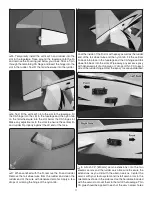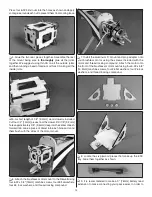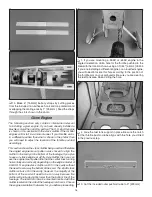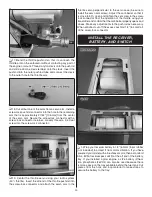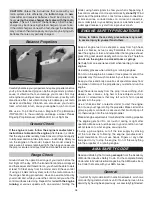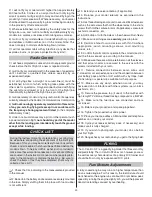
25
FULL
THROTTLE
RUDDER
MOVES
RIGHT
ELEVATOR
MOVES DOWN
RIGHT AILERON
MOVES UP
LEFT AILERON
MOVES DOWN
4-CHANNEL RADIO SET UP
(STANDARD MODE 2)
❏
3. Make certain that the control surfaces and the throttle
respond in the correct direction as shown in the diagram.
If any of the controls respond in the wrong direction, use
the servo reversing in the transmitter to reverse the servos
connected to those controls. Be certain the control surfaces
have remained centered. Adjust if necessary.
Set the Control Throws
Use a Great Planes AccuThrow (or a ruler) to accurately
measure and set the control throw of each control surface
as indicated in the chart that follows. If your radio does not
have dual rates, we recommend setting the throws at the
low
rate setting.
NOTE
: The throws are measured at the
widest part
of the
elevators, rudder and ailerons.
These are the recommended control surface throws:
ELEVATOR
HIGH
LOW
1"
[ 25 mm]
15°
3/4"
[19 mm]
11°
15/16"
[ 24mm]
12°
5/8"
[16 mm]
8°
2-1/2"
[ 64 mm]
23°
1-1/8"
[ 29 mm]
10°
RUDDER
AILERONS
3D
2-5/16"
[ 59mm]
36°
1-1/2"
[ 38 mm]
20°
4"
[102 mm]
39°
Up & Down
Up & Down
Right & Left
IMPORTANT:
The U-Can-Do SF has been
extensively
fl own and tested to arrive at the throws at which it fl ies best.
Flying your model at these throws will provide you with the
greatest chance for successful fi rst fl ights. If, after you have
become accustomed to the way the U-Can-Do SF fl ies, you
would like to change the throws to suit your taste, that is fi ne.
However, too much control throw could make the model
diffi cult to control, so remember, “more is not always better.”
The pushrod farther out
means
More Throw
The pushrod closer in
means
Less Throw
The pushrod farther out
means
Less Throw
The pushrod closer in
means
More Throw
At the Servos
At the Control Surfaces
❏
1. If necessary, adjust the location of the pushrod on the
servo arm or on the elevator horn, or program the ATVs in
your transmitter to increase or decrease the throw according
to the measurements in the control throws chart.

